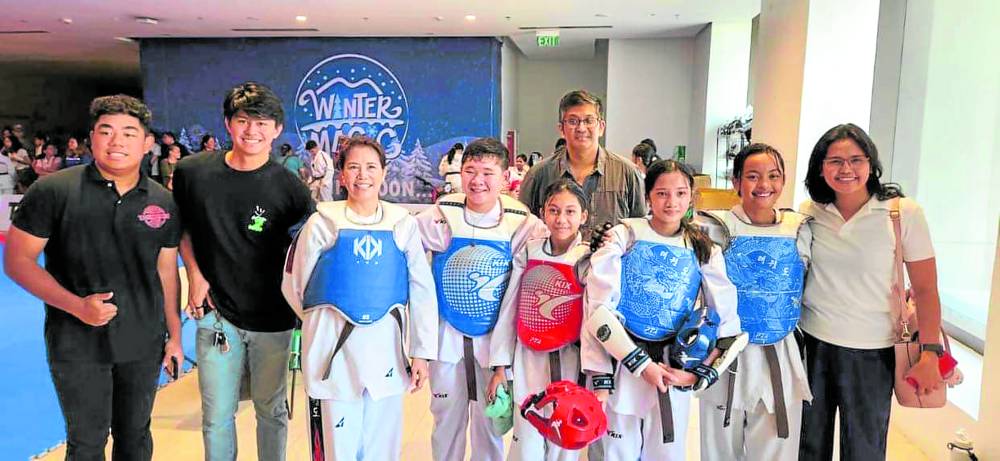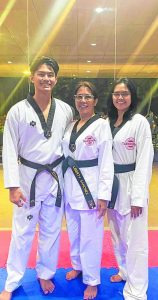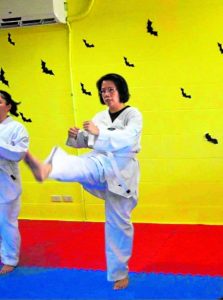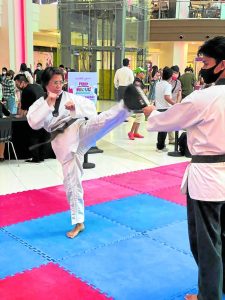How this grandma got her taekwondo black belt

Liberty “Nina” Sanchez-Arcilla is 57, a mother of four, and a grandmother of three. She also just earned her taekwondo (TKD) black belt.

Growing up, Nina was never an athlete but did well in her Physical Education classes. Her daughter Kaez teaches at Ampongan Taekwondo Academy (ATA) and encouraged her to attend the adult classes.
“I was hesitant because, for me, TKD is for the young ones, not for the young once and the young at heart,” admitted Nina. She suffered from back pain from her scoliosis, which she acquired from years of working as a nurse at San Juan de Dios Educational Foundation College.
At her first promotion test, she was asked by the examiner why she was doing TKD. Nina replied, “For physical fitness.” With years of training, her back pain disappeared, and she lost 20 pounds.
The road to getting her black belt took Nina eight years. She started TKD at 49 years old.
“I was the youngest at heart in ATA,” she said with a smile. “My goal was to be a black belt, but my body told a different story. During warmups, I would pant so much. My 45-kick was only hip-high, my split was less than 90 degrees, and I couldn’t touch my toes. But with regular training, my stamina and flexibility slowly improved. These, plus the encouragement of my daughter/coach, pushed me to continue. My son became my coach when he became a black belt, too, so the pressure to become one doubled. I am so proud that two of my children are black belts who compete and win locally and internationally.”
Why taekwondo?

Nina’s grandchildren all do TKD with their aunt and uncle as their coaches. They find taekwondo a fun physical activity that builds self-confidence, enhances self-esteem and improves concentration.
“When I got promoted to yellow belt, I was so proud of myself!” said Nina. She continued training weekly at the studio and did strengthening exercises at home. At the next promotion test, she skipped straight to the blue belt. She became a brown belt after five years of training.
Then the pandemic happened, and TKD adapted online. “For the first few months, I continued training. But I stopped because working from home was demanding, and I lost focus,” she said. “I gained a few pounds and lost my flexibility after a year of no training.”
When ATA resumed face-to-face classes in Alabang West Parade, she joined the little kids’ class every Saturday. When the studio reopened and adult classes resumed, Nina returned to full training even if she was the only student in class at first.
Challenges
“The downside to being an older adult TKD practitioner is the memorization of the poomsae (forms). Every promotion test is difficult for me because I have to memorize the forms and I’m forgetful. So I had to practice every day. Coaches say muscle memory is the key,” she said.

In preparing for her black belt promotion test, she trained hard—with teens. “I had to keep up and push myself to get close to their level,” said Nina. After work, she would jog—for 20 minutes at first, then in two weeks, for 40 minutes. By week four, she was jogging up to an hour thrice a week and doing 500 kettlebell swings in between nonjogging days.
On the day of the black belt promotion test, her daughter and her son expressed their faith in her. “If they say I can do it, then I believe I can do it!” Nina recalled. “I was the most advanced in age in the group, so I got a few discounts: fewer squats, push-ups and squat thrusts. Even if I knew I could do the same, I obeyed and didn’t show off.”
In the poomsae portion, candidates had to do the taegeuk forms asked. Although she had practiced taegeuk as many as eight times over the past two months, her memory still failed her. “But I didn’t give up; I just paused, took a deep breath, and finished it correctly.”
Then, in the sparring segment, Nina was “discounted” again. “I was told to stay on the side for the first set and sparred in the next two sets,” she said.
Never too late
She had to wait a week and continued training for the black belt awarding ceremony. “It was the greatest achievement in my TKD journey. I finally received my black belt!” Nina said.
If there’s anything she would’ve done differently, she would’ve done TKD in her younger years when she was more flexible with more stamina. “I should have also trained daily, especially the poomsae, so I won’t forget!”
Nina encouraged those thinking of following her path: “Thanks to ATA’s adult classes, it’s never too late! This sport can be for all ages, even without experience in any sports. Parents whose children are doing TKD, join your kids so you can bond during home training. To older adults, don’t feel embarrassed to start; even if you kick low or feel you’re not as good or fast as your classmates, you’ll get better. They are just ahead of you! Find a gym with classes like ATAs that accommodate beginners nicely so you won’t feel left behind.”What are her plans now that she’s achieved this feat? Nina said, “Our coach, Sir JP Ampongan, said that being a black belt is not the end but the beginning. My daughter said it opens the door to the next stage. Being a black belt now doesn’t make me better than you; it only means I am ahead of you. So, I will continue training for my physical fitness. Maybe compete in poomsae, maybe teach. It doesn’t hurt to dream.” —CONTRIBUTED INQ















